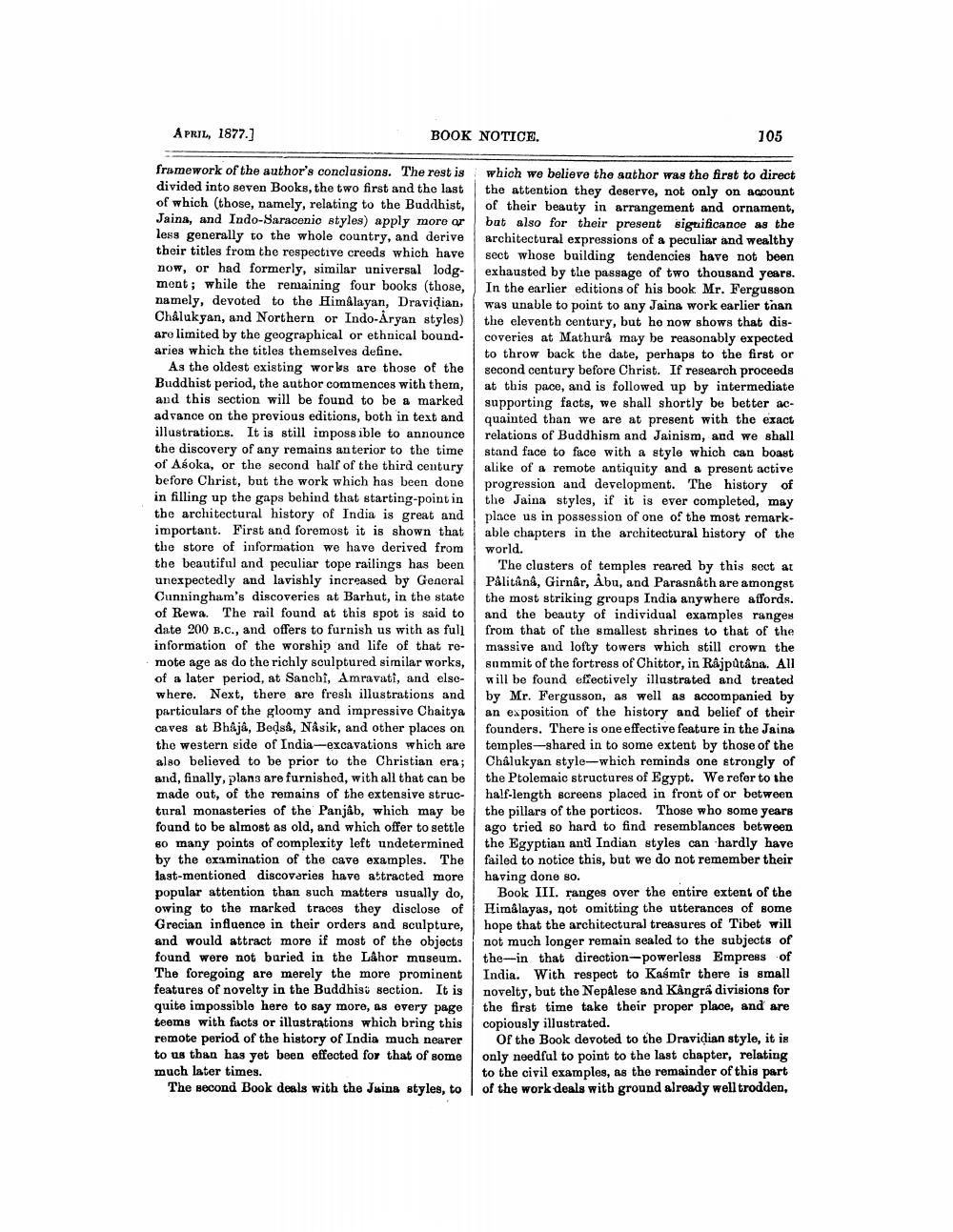________________
APRIL 1877.]
BOOK NOTICE.
105
framework of the author's conclusions. The rest is divided into seven Books, the two first and the last of which (those, namely, relating to the Buddhist, Jaina, and Indo-Saraconio styles) apply more or less generally to the whole country, and derive their titles from the respective creeds which have now, or had formerly, similar universal lodgmont; while the remaining four books (those, namely, devoted to the Himalayan, Dravidian, Chalukyan, and Northern or Indo-Aryan styles) are limited by the geographical or ethnical boundaries which the titles themselves define.
As the oldest existing works are those of the Buddhist period, the author commences with them, and this section will be found to be a marked advance on the previous editions, both in text and illustrations. It is still impossible to announce the discovery of any remains anterior to the time of Asoka, or the second half of the third century before Christ, but the work which has been done in filling up the gaps behind that starting-point in the architectural history of India is great and important. First and foremost it is shown that the store of information we have derived from the beautiful and peculiar tope railings has been unexpectedly and lavishly increased by General Cunningham's discoveries at Barhut, in the state of Rewa. The rail found at this spot is said to date 200 B.C., and offers to furnish us with as full information of the worship and life of that re- mote age as do the richly sculptured similar works, of a later period, at Sanobi, Amravati, and else- where. Next, there are fresh illustrations and particulars of the gloomy and impressive Chaitya caves at Bhaja, Bedsa, NÅsik, and other places on the western side of India-excavations which are also believed to be prior to the Christian era; and, finally, plans are furnished, with all that can be made out, of the remains of the extensive structural monasteries of the Panjab, which may be found to be almost as old, and which offer to settle 80 many points of complexity left undetermined by the examination of the cave examples. The last-mentioned discoveries have attracted more popular attention than such matters usually do, owing to the marked traces they disclose of Grecian influence in their orders and sculpture, and would attract more if most of the objects found were not buried in the Lahor museum. The foregoing are merely the more prominent features of novelty in the Buddhist section. It is quite impossible here to say more, as every page teoms with facts or illustrations which bring this remote period of the history of India much nearer to us than has yet been effected for that of some much later times.
The second Book deals with the Juina styles, to
which we believe the author was the first to direct the attention they deserve, not only on account of their beauty in arrangement and ornament, but also for their present significance as the architectural expressions of a peculiar and wealthy sect whose building tendencies have not been exhausted by the passage of two thousand years. In the earlier editions of his book Mr. Fergusson was unable to point to any Jaina work earlier than the eleventh century, but he now shows that discoveries at Mathurà may be reasonably expected to throw back the date, perhaps to the first or second century before Christ. If research proceeds at this pace, and is followed up by intermediate supporting facts, we shall shortly be better acquainted than we are at present with the exact relations of Buddhism and Jainism, and we shall stand face to face with a style which can boast alike of a remote antiquity and a present active progression and development. The history of the Jaina styles, if it is ever completed, may place us in possession of one of the most remarkable chapters in the architectural history of the world.
The clusters of temples reared by this sect at Palitana, Girnar, Abu, and Parasnáth are amongst the most striking groups India anywhere affords. and the beauty of individual examples ranges from that of the smallest shrines to that of the massive and lofty towers which still crown the summit of the fortress of Chittor, in Rajputana. All will be found effectively illustrated and treated by Mr. Fergusson, as well as accompanied by an exposition of the history and belief of their founders. There is one effective feature in the Jaina temples-shared in to some extent by those of the Châlukyan style-which reminds one strongly of the Ptolemaic structures of Egypt. We refer to the half-length screens placed in front of or between the pillars of the porticos. Those who some years ago tried so hard to find resemblances between the Egyptian and Indian styles can hardly have failed to notice this, but we do not remember their having done so.
Book III. ranges over the entire extent of the Himalayas, got omitting the utterances of some hope that the architectural treasures of Tibet will not much longer remain sealed to the subjects of the--in that direction-powerless Empress of India. With respect to Kasmir there is small novelty, but the Nepalese and Kångra divisions for the first time take their proper place, and are copiously illustrated.
of the Book devoted to the Dravidian style, it is only needful to point to the last chapter, relating to the civil examples, as the remainder of this part of the work deals with ground already well trodden,




